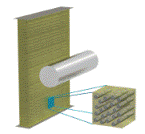Mechanical & Materials Engineering, Department of
Date of this Version
8-2009
Abstract
Physical aging and plastic flow are known to cause changes in the properties of glassy polycarbonate (PC). Although the individual effects of physical aging and plastic flow have been studied, the combined mechanical and thermal effects have yet to be evaluated for PC at large plastic strains. This work is the first characterization of the combined effects in PC of large plastic flow followed by thermal (physical) aging. To conduct this study, samples were prepared with different extents of plastic compressive strain, up to approximately 50% engineering strain, followed by thermal aging up to 135 °C, with various aging times up to 6000 hours. These samples were then studied by conducting Charpy impact, quasi-static single-edge notched bending (SENB), differential scanning calorimetry (DSC), dynamic mechanical analysis (DMA), and temperature-modulated DSC (TMDSC) tests.
The main content of this thesis is the description of the experimental setup and its evaluation, and a preliminary study of the results. The Charpy impact, quasistatic SENB, DSC, DMA, and TMDSC results are the first for PC at large plastic flow in the glassy state followed by physical aging.
Charpy impact and quasi-static SENB tests provide information about crack initiation and propagation, and were conducted on PC to study the effect on failure of plastic flow followed by physical aging. For these tests, samples were cut with two orientations relative to the axis of the initial compression, labeled as TA and TT samples. The first letter denotes that the sample is cut with its long axis oriented transversely (T) to the axis of compression and the second letter denotes the direction of crack propagation, either axial (A) or transverse (T) to the axis of compression. Even though preliminary, this study shows a distinct anisotropic characteristic to the sample response during failure, with a measurable effect from both plastic deformation and from physical aging. As expected, the Charpy impact results show that plastic compression increases the toughness while physical aging has a large effect in increasing the brittleness. The quasi-static SENB tests provide more detailed information, yet provide similar results.
DSC tests were performed on PC samples with plastic compressions up to 40% engineering strain followed by physical aging at 105 °C, 125 °C, and 135 °C for aging times up to 6000 hours, 700 hours, and 300 hours, respectively. A LabView program was developed to calculate the relevant thermal parameters for these tests, which has been adopted in the laboratory for studying all DSC results. The results for the samples aged at 125 °C are presented in detail, showing the effect of both plastic compression and thermal aging on a number of measures of the glass transition. Even though, in general, the effect of physical aging in uncompressed and compressed samples show similar trends, plastic deformation did effect the short and long term aging differently.
DMA and TMDSC tests were also performed on a large number of samples, but are only briefly discussed in this thesis.
The goal of this preliminary work was to establish the effect of plastic deformation followed by thermal aging, particularly for large plastic deformations. The work suggests that in some measurements there is a clear difference between the small and large plastically deformed samples, but that other measurements are not affected by plastic flow at all. In particular, there is a substantial anisotropic effect on fracture properties, which might be considered one of the most important results of this work.


Comments
A THESIS Presented to the Faculty of The Graduate College at the University of Nebraska In Partial Fulfillment of Requirements For the Degree of Master of Science, Major: Engineering Mechanics, Under the Supervision of Professor Mehrdad Negahban. Lincoln, Nebraska: August, 2009.
Copyright 2009 Kyle W. Strabala.